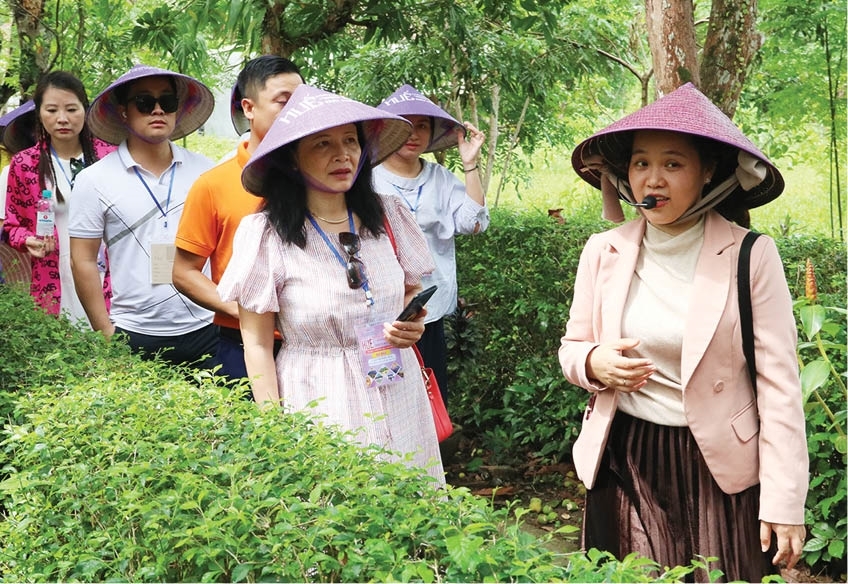Hue is beautiful, clean, and green
The tourist raised her question after the guide shared that solely in the first quarter of 2025, Hue welcomed nearly 1.5 million visitors, a 62% increase year-over-year; of these, international tourists accounted for over 666,000, increasing by nearly 50%. Along with this growth, Hue has always preserved its heritage and natural resources remarkably well, impressing many visitors.
Not only Ms. Sandrine but also many other domestic and international visitors have shared the same impression of a “very green” Hue. Having the same question as Ms. Sandrine, Mr. Andreas, a German tourist, visited the Thuy Bieu eco-tourism site to better understand how the locals practice tourism. Under the summer sun, Thuy Bieu welcomed Andreas with the cool shade of trees and fragrant pomelo gardens. Local tourism operators offered him peeled pomelo fruit and a relaxing herbal foot soak. They even exchanged his plastic water bottles with glass ones. At that moment, Mr. Andreas said, “Perhaps I’ve found the answer: Hue is beautiful because it is green and has preserved its original values. The efforts of local authorities, the tourism sector, and the community have created something truly remarkable.”
Many tourists went from being unfamiliar with green practices to becoming fully engaged in reducing plastic use and supporting green tourism in Hue. Mr. Trần Quang Hào, Director of Huetourist Travel Services, said that from using electric cars and bicycles to organizing market visits without plastic bags, people working in the local tourism also shared inspiring stories about green tourism in Hue - stories that tourists loved. Tourists are highly concerned about environmental factors, and once they understand Hue’s tourism approach, they fully support it. This demand and support have further motivated and inspired local tourism operators in Thuy Bieu. Previously, each tour that came to visit, experience, and stay at Luong Quan - Nguyet Bieu was provided with bottled drinking water, and all the items used in accommodation were single-use or disposable plastic items, but now they have been replaced by environmentally friendly products.

Tourists visiting Phuoc tich ancient village. Photo: Huu Phuc
Bringing Hue into a green destination
With over 64,000 street trees, surpassing the greenery standards for a first-tier city, Hue has the highest green density in the country. These trees not only serve as the “green lungs” protecting residents from the harsh summer sun but also bring peace and a sense of healing to visitors.
Hue boasts numerous historical heritage sites and natural resources such as the Complex of Hue Monuments, the poetic Perfume River, Tam Giang - Cau Hai, the largest lagoon system in Southeast Asia, and the Rú Chá mangrove forest, etc. In addition to historical value, Hue’s destinations also offer great potential for eco-tourism and green tourism development.
Hue City’s green tourism development orientation is aligned with the objectives set forth in Resolution No. 54-NQ/TW, dated December 10, 2019, issued by the Politburo on the construction and development of Thua Thien Hue (now Hue City) towards 2030, with a vision to 2045: “To build and develop Thua Thien Hue into a centrally governed municipality, based on the preservation and promotion of the heritage values of the former imperial capital and Hue’s cultural identity, characterized by culture, heritage, ecology, landscape, environmental friendliness, and smart development.”
The local tourism sector has been following the right direction by developing attractive tourism packages in line with current travel trends, particularly emphasizing the theme of “green tourism,” such as wellness retreats, culinary tourism combined with sustainable and eco-friendly dining models. Currently, Hue has established public bicycle-sharing stations throughout the city and has developed several community-based tourism sites, such as exploring traditional garden houses in Kim Long, the ancient village of Phuoc Tich, the Thanh Toan tiled-roof bridge area, and traditional ethnic minority villages along the Ho Chi Minh route through A Luoi District. In addition, the People's Council of Hue City has introduced various policies to support the development of community-based tourism, as well as to preserve and promote the unique values of traditional garden houses and Hue ancient rườnghouse (beamed house).
According to leaders of the Department of Tourism, the Project on the Development of Tourism and Tourism Services in Hue City for the period 2025–2030 with a vision to 2045 outlines a vision and objectives for inclusive and sustainable tourism based on green growth. It emphasizes the development of cultural tourism, harmonizing economic growth with heritage conservation and the promotion of national cultural identity; protecting ecological environments, efficiently utilizing natural resources, safeguarding biodiversity, adapting proactively to climate change, and ensuring national defense and security.
The Department of Tourism has issued a plan to reduce plastic waste in the local tourism sector for the period 2023–2025 and is working closely with the “Hue - Plastic Smart Cities in Central Vietnam” project, the Tourism Association, and localities to implement action programs and promote plastic reduction practices. In the coming period, efforts will continue to upgrade tour routes and service types associated with green tourism - especially eco-tourism and wellness tourism - while also developing attractive tourism packages aligned with current trends and traveler demands, with a focus on the green tourism theme.
To many tourists, Hue stands out for its green trees, the Perfume River, and the way local people embrace eco-friendly and rustic tourism practices. Thanks to its commitment to green tourism, many travelers have fallen in love with Hue and return often — seeking healing and immersing themselves in this green tourism city.